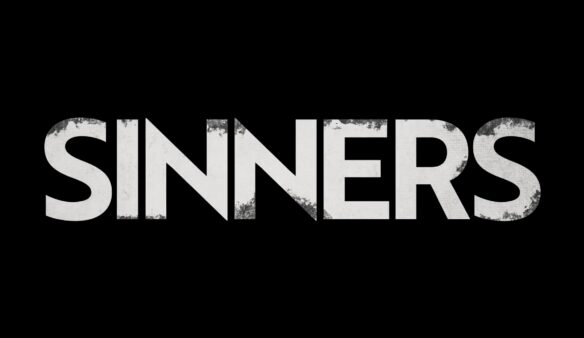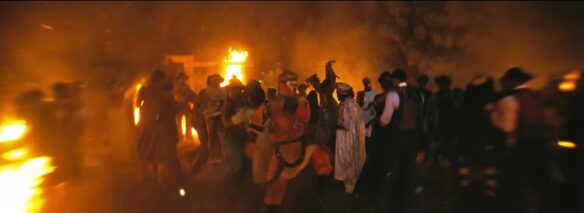
SPOILER WARNING: Review discusses some details of story
Review by Jonathan Cowie: Sinners (2025) is the latest offering from director Ryan (Black Panther & Wakanda Forever) Coogler. It is at the end of the day a vampire film but, like the recent Russian film Putin hates, Empire V, it actually uses the trope of vampires as an allegory for person control and identity. Indeed, nearly all the first half of the film does not feature vampires (though there is a fleeting segment a few minutes long) with their first principal entrance coming 55 minutes in. Instead, we get to see what life is like for early 20th century African Americans in the south.
But, before we get ahead of ourselves, some backdrop. The film is set in the Mississippi Delta which, for many outside of the US, should not be confused with the geographical delta of the Mississippi river but note that the Mississippi Delta is a region in the north of the USA state of Mississippi that lies between the Mississippi and Yazoo rivers a couple of hundred miles or so north of the geographical delta proper.
Sinners’ 1932 setting brings it to the heart of the time when many in the region refused to accept the South had lost the American Civil War that should have seen former enslaved ethnic minorities treated as equals (as per the US constitution) but saw continued abuse, harassment, degradation and control over these minorities, not least with a flourishing Klu Klux Klan in the region. This then is at the heart of the film.
Part of this abuse is the appropriation of blues music by the privileged white folk who on one hand enjoy it, and culturally appropriate it, but on the other hypocritically call it sinful and the devil’s music due to its ethnic origins. As a pianist, Delta Slim, in the film says, “White folks like the blues just fine; just not the people who make it.” Here, it should be noted that African-Americans were not the only ethnic minority to be abused: those from China were too and there are a number of references to this.
As said, the film’s first 55 minutes sets all this up together with the protagonists’ own backstory.
In fact, the film’s first five minutes or so takes place the day after the events of the rest of the film. So the first thing we see, and get to know, is that there is a survivor in the form of cousin Sammie (played by Miles Caton the R&B singer-songwriter) who is an aspiring blues guitarist who goes to his pastor father’s (Jedidiah Moore – played by Saul Williams) church. Sammie, in a state of disarray and distress, bursts in on his father giving a service to his congregation. His pastor father pleads with Sammie to renounce the evil blues and seek salvation… We then get a flashback to the previous day.
Twins – both played by Michael B. (Black Panther) Jordan with some nifty photography including them side-by-side with one hand-rolling a cigarette and passing it to the other – return to the area they grew up in having spent a spell working for Chicago gangsters and before then being World War I veterans: they are battle hardened through both crime and war.
With their gangster cash they decide to go legit and set up a juke joint outside Clarkesdale. They purchase their ramshackle premises from a wealthy landowner who clearly is bigoted given the use of some of his (no offence intended) language.
While the twins are preparing their juke house, and recruiting staff from former friends in Clarksdale to help run it, we get a brief interlude in which a very dusty (smoking even) Irishman stumbles from the plain into a young couple’s homestead: we get to see, from a brief display of robes, that the couple are local Klansmen. The Irishman asks to be let in seeking sanctuary from some American Indians who are after him. Shortly, a group of Choctaws turn up asking the wife if anyone has arrived and warning that they are in danger. However, the Sun is about to set and so the Choctaw leave but not before warning the wife not to invite any strangers in… However, the wife goes back into their homestead to find that the Irishman has killed her husband, having drunk his blood…
Meanwhile, the Sun has set and the juke house’s opening night is going well with Sammie, their blue’s guitarist, on top form. The blues is such a powerful music that it can open the doors to the past as well as the future and other spiritual plains. We get to see primitives dancing as well as modern DJ’s with their turntables and modern musicians with electric guitars, while the juke house is seemingly on fire.
This music, opening other planes and dimensions, attracts the Irish vampire who turns up with the Klansmen couple asking to be invited in…
With the best part of an hour to go, the film sees the inevitable stand-off with the vampires as one by one the revelers are turned. There then follows two codas: one a conclusion to the Klansmen issue and the other an in-post-film credits afterword set in the present day…. As for how this hour plays out you will have to see the film.
Plot aside, you may want to know what sort of vampires it is with which we are dealing? We learn that these vampires, having drunk the blood and turned their victims, learn all that their victims knew and their victims demonstrably get to know what their vampire master knows as at one point this leads to a co-ordinated dance.
Fortunately, at least as far as I am concerned, that, unlike the recent Wolf Man film I reviewed which eschewed traditional werewolf tropes, Sinners vampires: do not like garlic, have to be invited in, do lethally suffer from extreme sunburn, and are killed with a stake through the heart. In this respect, Sinners is a solid, traditional vampire film.
This is also a film to see in the cinema for both the photography and music. The scenery of the Delta plains lends itself to the widescreen and the 1930s Clarkesdale is portrayed well. The music was composed by Ludwig Goransson and benefits from cinematic sound. Apparently, much of the music was recorded on set with musicians alongside cast members.
With regards to the film’s feel, it does at times – especially to my mind the Choctaw scene – reminiscent of the director John Carpenter, whom Coogler has reportedly cited as an influence. Indeed, I wanted to know more of the Choctaw backstory.
Here, there may be some good news. Apparently, Warners went into an unusual arrangement with director-producer Coogler in that he has control over future licensing, royalties, and sequels. Could it be that we will get to know more of the Choctaw backstory?
Discover more from File 770
Subscribe to get the latest posts sent to your email.



Thank you for this review. I’ll need to see this (and suggest it to one of my Blues’-loving friends)
Can you clarify this phrase “as an allegory for person control and identity” which might be missing a word?
Cheers @Andrew
Instead of ‘person control’ how about ‘coercive control’?
https://en.wikipedia.org/wiki/Controlling_behavior_in_relationships
Thanks. How about “as an allegory for coercive control and its effect on personal identity”?
I have to second, third, fourth, whatever, the recommendations for Sinners. Absolutely amazing, especially since as a blues DJ, fan of traditional Irish music, dancer, and former vampire-fiction collector, it pretty much hits my sweet spot from every possible direction. I walked out of the theater gasping and cursing from sheer emotional overload.
Warning: don’t check the Wikipedia page for this film; it’s got detailed spoilers.
For people who (like me) are not generally fans of horror films and squeamish about gore, this one is surprisingly moderate on the blood-and-guts (and, um, those squirty stage blood packs are so fake and quite low on jump-scares. I tolerated the horror aspect just fine.
Sinners is going to be on my Hugo nominating ballot next year for sure.
Worth seeing for the music alone. And I do hope Jordan got paid twice. Two parts, two salaries: that’s how it works, right?